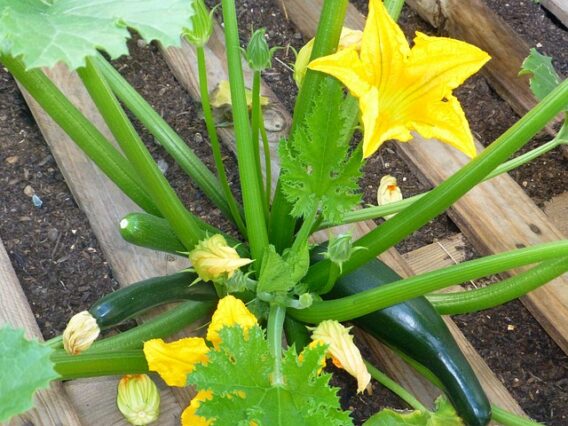Courgettes are one of the easiest crops to grow, and once they get going they look great in a garden border as well as in a vegetable plot.

Courgettes are an abundant crop. Just a couple of plants will give you enough courgettes to eat each week throughout the summer. Leave the courgettes to grow bigger and you get marrows!
Courgettes and marrows are good when eaten fresh, but they are also a fantastic ingredient for making chutneys and pickles. The flowers from courgette plants can also be eaten and are delicious when coated in a batter and fried.
Sowing Courgette Seeds
Courgette seeds can be sown indoors from April, ready to be planted out from June onwards. It is more convenient to sow into small pots, as the plants get large quickly and it minimises root disturbance when planting out.
Seeds can also be sown into soil from May onwards. If you sow two seeds, you have a back-up if one does not germinate.
You can buy quality courgette seeds from Thompson & Morgan.
Planting Courgettes
Courgettes like a very fertile soil, so prepare the soil by adding in plenty of garden compost or manure. You could even try to grow one on the top of a compost heap, as long as it won’t be disturbed. Choose a sunny position.
Caring for Courgette Plants
Courgette plants like moist soil and when they are established they benefit from plenty of water, especially in hot weather. Apply a mulch to help the soil retain moisture. Do not over water young plants as this can make the stem prone to rot.
Young plants might need some protection form slugs and snails, but as the stems become hairy as they grow bigger, pests are naturally deterred. Read more about natural pest control.
If you have added organic material to the soil before planting, there is little need for fertiliser.
Courgette plants have both male and female flowers, and pollination usually takes place though the activity of insects.
Female flowers have a swelling behind them, whereas the male flowers do not. You can give the plants some pollination help by taking a male flower and transferring pollen to the centre of the female flowers. This will encourage the development of fruits.
Harvesting Courgettes
Regularly harvesting courgettes will ensure the plant keeps on producing. Once a courgette has reached a good size for eating, cut it off the plant with a knife. Production does slow once you leave the plant to produce a marrow.
Courgettes will last for a week in a fridge, and marrows will store for longer in a cool place.

